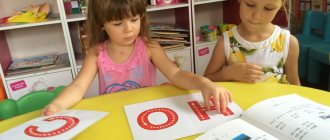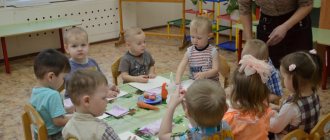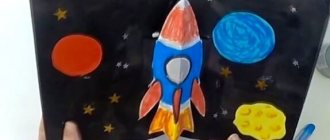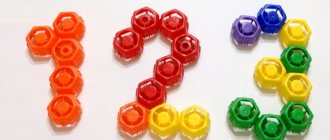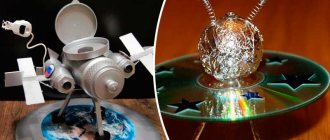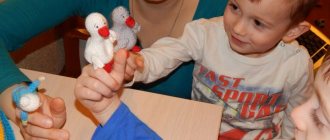We launch a rocket into space.
I included this game as a “recess” so that the child could rest and play before the next task.
We took our constructed lego rocket and played launch. “Five-four-three-two-one-GO!” Our rocket flew through the airless space of the room and every now and then landed on different “planets”. At the end, the rocket returned home, the astronauts were greeted with applause and shouts of “Pos-drav-la-yu!” (everything is like in life). Dasha liked the moment of meeting the cosmonauts the most - she had to meet them three times.
A musical moment.
This minute was introduced to relax between tasks. I suggested that Dasha listen to “cosmic music”. We lay down on the pillows and turned on the music (this one). While listening to music, you can fantasize about what it wants to tell us about (the child will listen with interest as the music talks about how the ship is flying between the stars and planets, how there is darkness and cold for hundreds of kilometers around, and how it flies - swift , fast, beautiful to a distant planet, etc.). Playing “what the music says” is a very good way to develop an ear for music and the ability to truly appreciate and listen to music.
Charging an astronaut
Flexible breaks between tasks are very important! Some children will not be able to conduct a lesson at all without them (we are just part of this group of “some” fidgets).
I told Dasha that we really need to fly into space, but only very strong people are accepted there and the astronauts train a lot before the flight. Therefore, we need to do good exercises.
The charging tasks were as follows (the pictures are not the most “designer” - I apologize, this is not my profile):
Exercise 1. Running around the room - for warming up.
Exercise 2. Walking on your toes, on your heels, walking along a massage path (any other massage surface - cereals, pebbles, pencils, etc.).
Fitball exercises.
(If you slightly change the exercises, you can use a simple ball of medium diameter. Attention! When performing all the exercises, hold the child tightly. You can secure the baby well if you take his two legs in your hands and press them tightly to the ball, and hold the ball itself with your feet. )
Exercise 3. We train the vestibular apparatus (everything like real astronauts). We sit the child on the ball, holding his legs tightly, and begin to bounce up and down on the ball (it turns out that the baby seems to be jumping on the ball). Then we place the child on his back on the ball and rotate the ball clockwise and counterclockwise.
We strengthen the abs and lower back muscles.
Exercise 4 . The child sits on the ball, the mother secures it well, taking both legs and pressing them to the ball (so as not to drop it! This is very important!). We begin to rock the child back and forth. We try to make the maximum possible amplitude.
Exercise 5. Swing the child on the ball left and right:
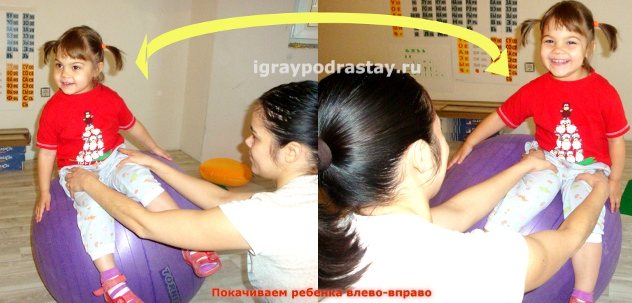
Exercise 6. Still fixing the child well, we rotate him and the ball in a plane parallel to the floor, clockwise and counterclockwise (as the green arrow in the photo suggests):
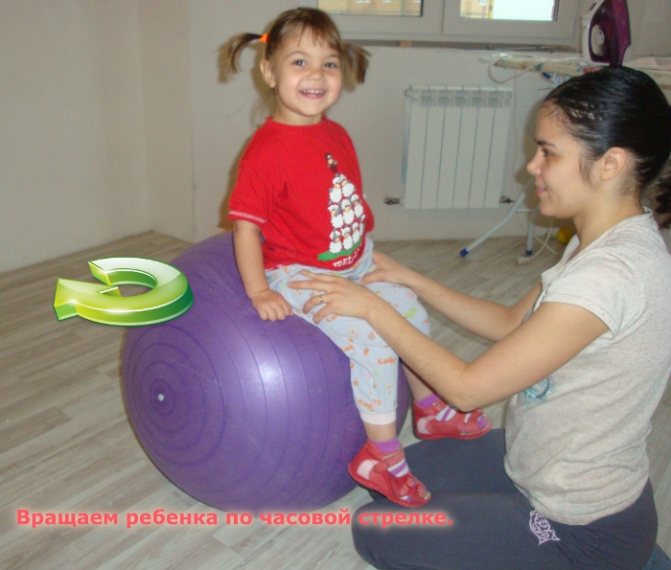
When performing these three exercises, the child will involuntarily deviate back and forth, while the abdominal and back muscles are well worked out.
Strengthening your arms and back.
Exercise 7. We ask the child to pick up toys from the floor (the toys are positioned so that he has to reach them in his arms):
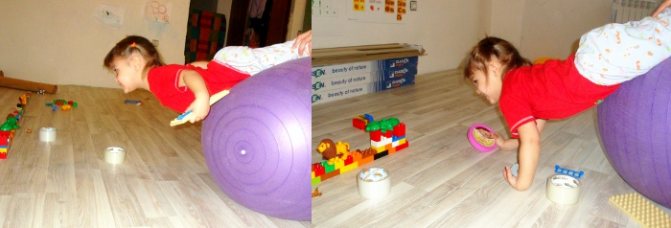
Exercise 8. We ask the child to raise his hands up - we fly up like a rocket. If the child does not comply with the request, you can ask him to take the toy that we hold above his head.
Exercise 9. Walking on your hands around the room is an excellent exercise for your arms, back, and abs:
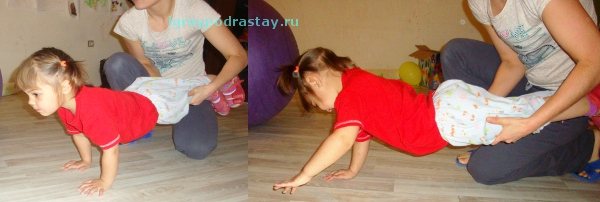
Exercise 10. Stepping over obstacles (strengthening the legs) - lay out tall objects on the floor (stuffed toys, pillows, stacks of books, anything taller than 30 cm). We ask the child to step over them (while raising his legs high).
We talk about our universe with the help of experiments
With the help of simple but effective experiments, it will be easier for you to explain to your child what space is. Below we present for you a small selection that your child will definitely like and help him understand.
Why don't we always see the full moon?
We take an ordinary table lamp and a ball. Rotate the ball so that, depending on the lighting, you can also see the full ball and only part of it in the form of a crescent. It's so easy to explain that we only see the illuminated part of the moon in the sky.
How a rocket flies
A very visual experiment with a balloon that will show your child the basic principle of a rocket taking off. We take a balloon, inflate it by hand, squeeze it with our finger, and then suddenly release it. The ball flies up, and when the air in it runs out, it falls. This is how a rocket flies. The only difference is that instead of air it has fuel, so during takeoff you can see fire and clouds of smoke.
The rocket consists of several parts. After takeoff, when the fuel runs out, the first part is disconnected, the engine of the second part is started, after the fuel is used up, it is also disconnected, and only one small, lightweight third part with the cosmonaut cabin goes into orbit.
You can watch how to make a rocket using the origami technique in the video on our channel “Rainbow Workshop”:
Galaxies
Galaxies are clusters of groups of stars united by vast distances. Our galaxy, which includes the entire solar system and beyond, is called the Milky Way. Galaxies can be of different shapes: spiral, elliptical, irregular. For example, the most famous galaxies, the Andromeda Nebula and the Milky Way, have a spiral shape.
Galaxies can collide with each other, pass through one another and merge into a new larger galaxy.

